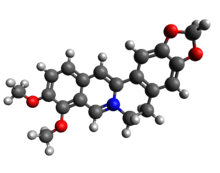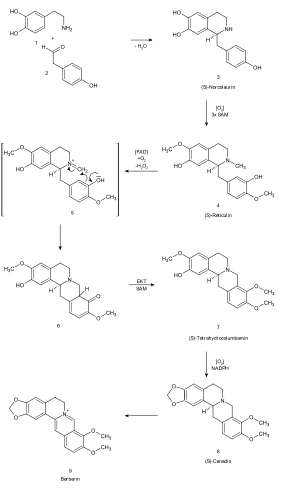


| |

| |
| Names | |
|---|---|
| IUPAC name
9,10-Dimethoxy-7,8,13,13a-tetradehydro-2′H-[1,3]dioxolo[4′,5′:2,3]berbin-7-ium | |
| Systematic IUPAC name
9,10-Dimethoxy-5,6-dihydro-2H-7λ5-[1,3]dioxolo[4,5-g]isoquinolino[3,2-a]isoquinolin-7-ylium[2] | |
| Other names
Umbellatine;[1] | |
| Identifiers | |
3D model (JSmol) |
|
| 3570374 | |
| ChEBI | |
| ChEMBL | |
| ChemSpider |
|
| DrugBank |
|
| ECHA InfoCard | 100.016.572 |
| EC Number |
|
| KEGG | |
PubChem CID |
|
| UNII | |
CompTox Dashboard (EPA) |
|
| |
| |
| Properties | |
| C20H18NO4+ | |
| Molar mass | 336.366 g·mol−1 |
| Appearance | Yellow solid |
| Melting point | 145 °C (293 °F; 418 K)[3] |
| Slowly soluble[3] | |
Except where otherwise noted, data are given for materials in their standard state (at 25 °C [77 °F], 100 kPa). | |
Berberine is a quaternary ammonium salt from the protoberberine group of benzylisoquinoline alkaloids, occurring naturally as a secondary metabolite in some plants including species of Berberis, from which its name is derived.
Due to their yellow pigmentation, raw Berberis materials were once commonly used to dye wool, leather, and wood.[4] Under ultraviolet light, berberine shows a strong yellow fluorescence,[5] making it useful in histology for staining heparininmast cells.[6] As a natural dye, berberine has a color index of 75160.
Studies on the pharmacological effects of berberine, including its potential use as a medicine, are preliminary basic research: some studies are conducted on cell cultures or animal models, whereas clinical trials investigating the use of berberine in humans are limited.[7] A 2023 review study stated that berberine may improve lipid concentrations.[8] High-quality, large clinical studies are needed to properly evaluate the effectiveness and safety of berberine in various health conditions, because existing studies are insufficient to draw reliable conclusions.[7]
Berberine supplements are widely available in the U.S. but have not been approved by the U.S. Food and Drug Administration (FDA) for any specific medical use. Researchers publicly warn that studies linking berberine to supposed health benefits are limited. Furthermore, the quality of berberine supplements can vary between different brands. A study conducted in 2017 found that out of 15 different products sold in the U.S., only six contained at least 90% berberine content.[9][10]
Berberine is usually found in the roots, rhizomes, stems, and bark.[12]

The alkaloid berberine has a tetracyclic skeleton derived from a benzyltetrahydroisoquinoline system with the incorporation of an extra carbon atom as a bridge. Formation of the berberine bridge is rationalized as an oxidative process in which the N-methyl group, supplied by S-adenosyl methionine (SAM), is oxidized to an iminium ion, and a cyclization to the aromatic ring occurs by virtue of the phenolic group.[13]
Reticuline is the immediate precursor of protoberberine alkaloids in plants.[14] Berberine is an alkaloid derived from tyrosine. L-DOPA and 4-hydroxypyruvic acid both come from L-tyrosine. Although two tyrosine molecules are used in the biosynthetic pathway, only the phenethylamine fragment of the tetrahydroisoquinoline ring system is formed via DOPA; the remaining carbon atoms come from tyrosine via 4-hydroxyphenylacetaldehyde.[15]
|
| |
|---|---|
| Other/ungrouped |
|
| Authority control databases: National |
|
|---|